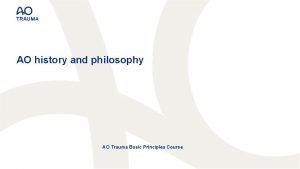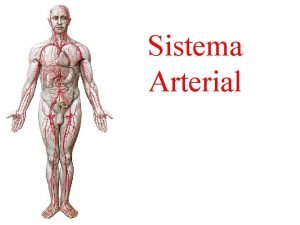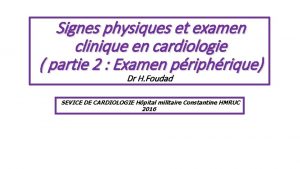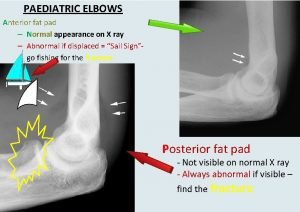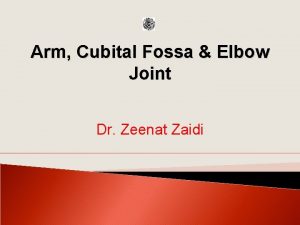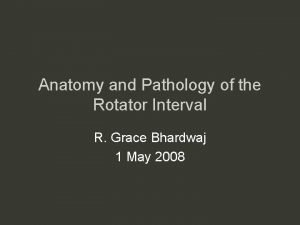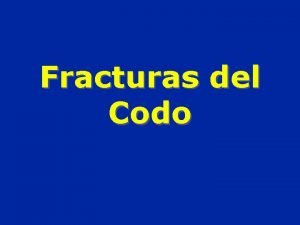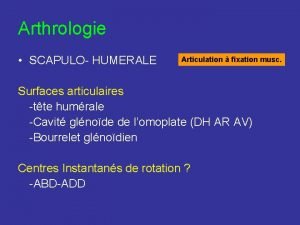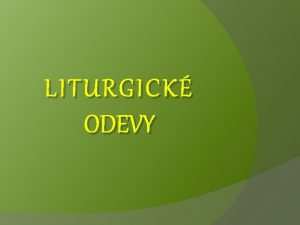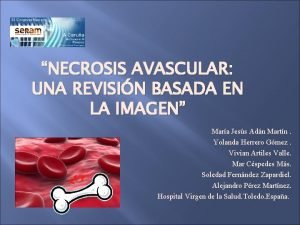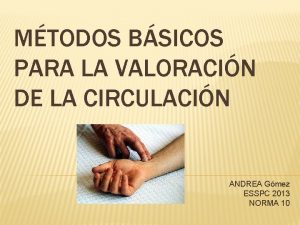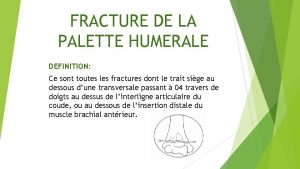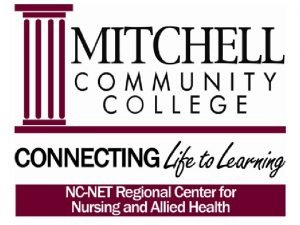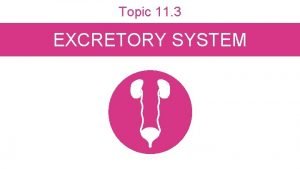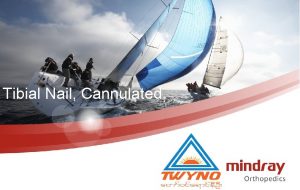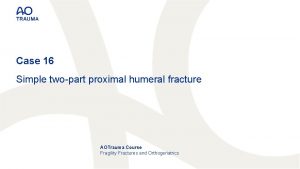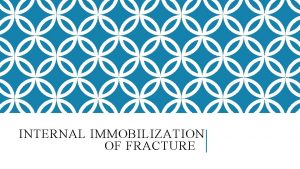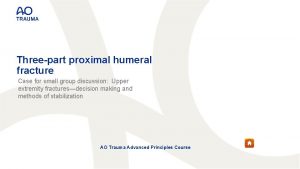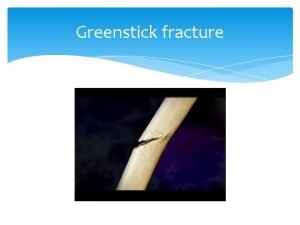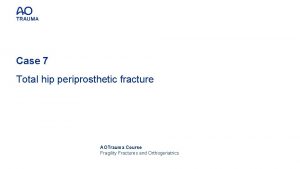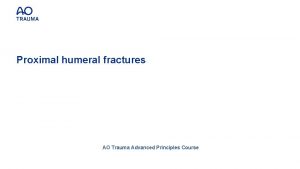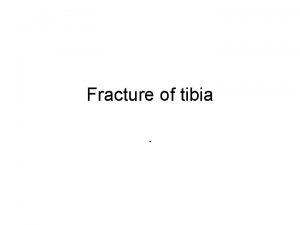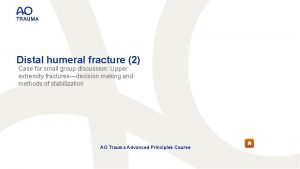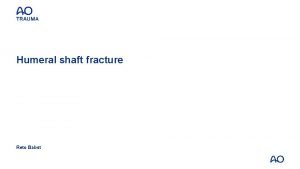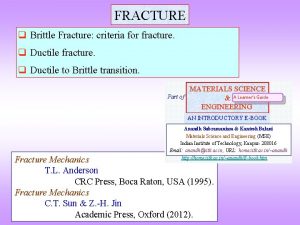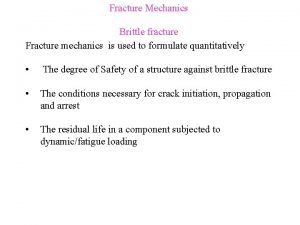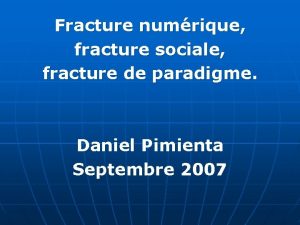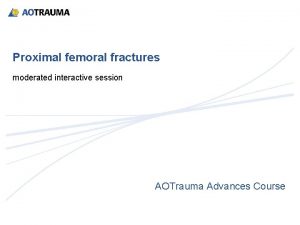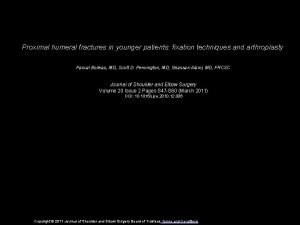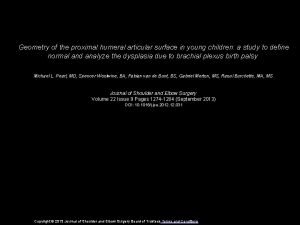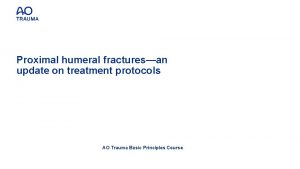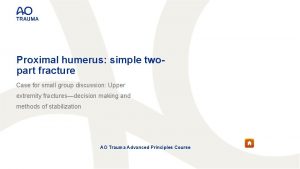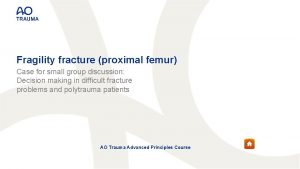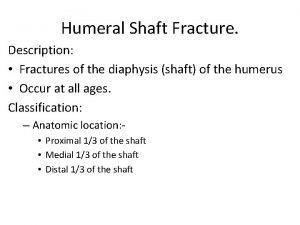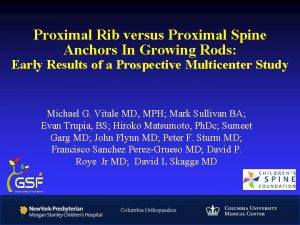Case 10 a Proximal humeral fracture AOTrauma Course























- Slides: 23

Case 10 (a) Proximal humeral fracture AOTrauma Course Fragility Fractures and Orthogeriatrics

Case description • • 87 -year-old man Former professor of urology Sustains a fall in his flat For many years has suffered dizziness, but no further falls in history • No known comorbidities, no drug treatment • Complains of massive pain in the right shoulder and some pain in the pelvis

X-rays of left shoulder

X-rays of pelvis

Patient information • Do you need further information? • Prefacture status: Parker score of 8, ADL 95 • He lives independently, together with his wife in their own house in Nuremberg • They receive some support for housework • They have two children, both physicians, daughter is an eye specialist in Switzerland, son is a plastic surgeon in the US • CT scans?

CT scan of left shoulder

CT scan of pelvis Surgical treatment?

Geriatric consultation • The patient is confused and agitated • He doesn‘t tolerate nursing • He suffers from urinary incontinence, but refuses a urinary catheter • Pain score 8 (using the VAS)

Medication • Enoxaparin 40 mg sc • Ibuprofen 400 mg 1 -1 -1 • Pantopralol 40 mg 1 -0 -0 Recommendations: • Hydromorphone ret. 2 mg 1 -0 -1 • Hydromorphone 1. 3 mg on demand • Macrogol for prophylaxis of constipation • 1000 ml Ringer infusion

Daughter demands further investigation • • CT of the brain Neurological examination because of a mild tremor Consultation by the cardiologist Consultation by the anesthesiologist

The next night • Patient becomes agitated during the night, he cries, and tries to get out of bed • Nursing was impossible • The staff use restraints and the physician on call prescribes 5 mg haloperidol IM • The following day the patient was transferred to the geriatric ward • The goal was to stabilize the patient regarding the delirium and afterwards go for elective surgery • Results of the CT scan: no bleeding, minimal vascular lesion, older genesis

Lab tests Hb Sodium Calcium CRP 12. 3 g/dl RR 128/68 mm. Hg 132 mmol/l HR 86/min 1. 98 mmol/l Temp. 37. 5° 8. 1 mg/gl ↑ (5. 3 two days earlier) Urine test: no sign of UTI Chest x-ray: no signs of pneumonia Infection yes or no? Antibiotic treatment?

Geriatric ward • Patient remains delirious and agitated, he is accompanied by his daughter • He gets a single room with an opportunity for the daughter to sleep in the same room • Antibiotic treatment with cefuroxim 1. 5 mg iv and fluid management • No urinary catheter but a urinal is provided • Physiotherapy is provided to mobilize him

Updated medication • • • Paracetamol 500 mg 1 -1 -1 -1 Metamizol 500 mg 1 -1 -1 -1 Vitamin D 3 20000 U per day Quetiapine 25 mg 0 -0 -0 -1 and on demand Dalteparin 5000 IU sc

Next day • Patient is deeply sedated, so physiotherapy or oral nutrition are not possible • His daughter still demands further investigation • Now what would you do? • Quetiapine medication is stopped and the daughter is informed about the problem of delirium • She is encouraged to become engaged in the care of her father

6 days later • Delirium improves over the days • During day hours the patient is reasonably comfortable but confusion and agitation occur primarily at night • CRP ↓ antibiotic treatment is stopped • Pain is well tolerated

6 days later

Interdisciplinary team meeting • Decision is made for nonoperative treatment, and to continue physiotherapy • Relatives are informed, discussion with them about the pro’s and con’s of surgery • Obtained a consensus with the patient and his family

A further 4 days later

Discharged day 12 • Patient still has mild delirium, but urinary incontinence is getting better • He is mobile with some help of one person, ambulatory physiotherapy is recommended • Medication now involves: • Paracetaol 500 mg 1 -1 -1 -1 • Vitamin D 3 20000 U per week

A further 3 weeks later • 3 weeks later, a phone conversation with his son • Situation at home is working, however, clinical situation is still the same

Take-home messages • In older patients, nonoperative treatment of proximal humeral fractures is a good option, even in displaced or fragmented fractures • Delirium is caused multifactorially and not always associated with anesthesia • If possible, nonpharmacological is better than pharmacological treatment • Information and cooperation with family members is extremely important

Thank you Return to list of cases
 Aotrauma reference
Aotrauma reference Cup and cone fracture
Cup and cone fracture Brachial artery
Brachial artery Todas las arterias transportan sangre oxigenada
Todas las arterias transportan sangre oxigenada Hypotension norme
Hypotension norme Fat pad sign
Fat pad sign Olecrannon fossa
Olecrannon fossa Transverse humeral ligament
Transverse humeral ligament Desplazamientos
Desplazamientos Lig coraco humeral
Lig coraco humeral Miništrantský odev
Miništrantský odev Gonalgia derecha
Gonalgia derecha Pulso pedio y tibial
Pulso pedio y tibial La palette humérale
La palette humérale Facio escapulo humeral
Facio escapulo humeral Best case worst case average case
Best case worst case average case Bryant's traction
Bryant's traction English bond t junction elevation
English bond t junction elevation Course title and course number
Course title and course number Course interne course externe
Course interne course externe 321 riq
321 riq Selective reabsorption in the proximal convoluted tubule
Selective reabsorption in the proximal convoluted tubule Distal proximal
Distal proximal Water is reabsorbed at the proximal convoluted tubule
Water is reabsorbed at the proximal convoluted tubule
